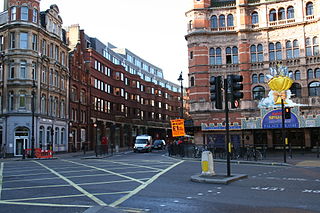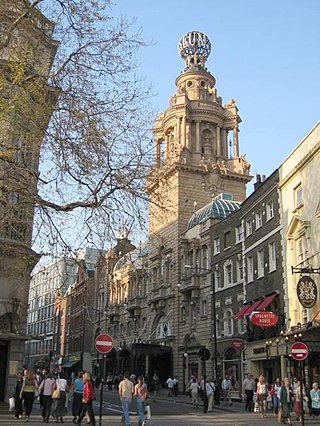
Charing Cross Road is a street in central London running immediately north of St Martin-in-the-Fields to St Giles Circus, which then merges into Tottenham Court Road. It leads from the north in the direction of Charing Cross at the south side of Trafalgar Square. It connects via St Martin's Place and the motorised east side of the square.

The West End of London is a district of Central London, London, England, west of the City of London and north of the River Thames, in which many of the city's major tourist attractions, shops, businesses, government buildings and entertainment venues, including West End theatres, are concentrated.

The Eleanor crosses were a series of twelve tall and lavishly decorated stone monuments topped with crosses erected in a line down part of the east of England. King Edward I had them built between 1291 and about 1295 in memory of his beloved wife Eleanor of Castile. The King and Queen had been married for 36 years and she stayed by the King's side through his many travels. While on a royal progress, she died in the East Midlands in November 1290. The crosses, erected in her memory, marked the nightly resting-places along the route taken when her body was transported to Westminster Abbey near London.

The Bakerloo line is a London Underground line that runs from Harrow & Wealdstone in suburban north-west London to Elephant & Castle in south London, via the West End. Printed in brown on the Tube map, it serves 25 stations, 15 of which are underground, over 23.2 kilometres (14.4 mi). It runs partly on the surface and partly through deep-level tube tunnels.

The Jubilee line is a London Underground line that runs between Stanmore in suburban north-west London and Stratford in east London, via the Docklands, South Bank and West End. Opened in 1979, it is the newest line on the Underground network, although some sections of track date back to 1932 and some stations to 1879.

The Northern line is a London Underground line that runs between North London and South London. It is printed in black on the Tube map. It carries more passengers per year than any other Underground line – around 340 million in 2019 – making it the busiest tube line in London. The Northern line is unique on the Underground network in having two different routes through central London, two southern branches and two northern branches. Despite its name, it does not serve the northernmost stations on the Underground, though it does serve the southernmost station at Morden, the terminus of one of the two southern branches.

The M4, originally the London-South Wales Motorway, is a motorway in the United Kingdom running from west London to southwest Wales. The English section to the Severn Bridge was constructed between 1961 and 1971; the Welsh element was largely complete by 1980, though a non-motorway section around Briton Ferry bridge remained until 1993. On the opening of the Second Severn Crossing in 1996, the M4 was rerouted over it.

Shaftesbury Avenue is a major road in the West End of London, named after The 7th Earl of Shaftesbury. It runs north-easterly from Piccadilly Circus to New Oxford Street, crossing Charing Cross Road at Cambridge Circus. From Piccadilly Circus to Cambridge Circus, it is in the City of Westminster, and from Cambridge Circus to New Oxford Street, it is in the London Borough of Camden.

Cambridge Circus is the partly pedestrianised intersection where Shaftesbury Avenue crosses Charing Cross Road on the eastern edge of Soho, central London. Side-streets Earlham, West, Romilly and Moor streets also converge at this point. It is halfway between Tottenham Court Road station, Oxford Street and the centre of Leicester Square, which is southwest of Charing Cross Road via Cranborne Street.

Chinatown is an ethnic enclave in the City of Westminster, London, bordering Soho to its north and west, Theatreland to the south and east. The enclave currently occupies the area in and around Gerrard Street. It contains a number of Chinese restaurants, bakeries, supermarkets, souvenir shops, and other Chinese-run businesses. The first Chinatown was located in Limehouse in the East End.

W & G Foyle Ltd. is a bookseller with a chain of seven stores in England. It is best known for its flagship store in Charing Cross Road, London. Foyles was once listed in the Guinness Book of Records as the world's largest bookshop in terms of shelf length, at 30 miles (48 km), and of number of titles on display. It was bought by Waterstones in 2018.

St Martin's Lane is a street in the City of Westminster, which runs from the church of St Martin-in-the-Fields, after which it is named, near Trafalgar Square northwards to Long Acre. At its northern end, it becomes Monmouth Street. St Martin's Lane and Monmouth Street together form the B404.
Devonshire Street was a short-lived railway station in the parish of Mile End Old Town, in the East End of London. It was opened on 20 June 1839 as a temporary London terminus of the Eastern Counties Railway (ECR) from Romford prior to the construction of Shoreditch station which became the permanent terminus.
Bunjies Coffee House & Folk Cellar was a cafe situated at 27 Litchfield Street, London WC2. Opened in 1953 or 1954, it was one of the original folk cafés of the 1950s and 1960s. Below the café, in a 400-year-old wine cellar, was an influential music venue which changed little until its closure in 1999. Allegedly named after the first owner's pet hamster, the venue featured, early in their careers, Tom Paxton, John Renbourn, Bert Jansch, Bob Dylan and Paul Simon. Al Stewart secured a residency at the Folk Cellar in 1965, at the age of 19, which was a significant factor in his later success.
Murder One was a bookshop in the Charing Cross Road from 1988 to 2009, "catering to readers interested in hard-to-find and collectable crime, mystery, romance and science fiction literature". It was the first UK bookshop to specialize in the crime and mystery genres, and at its opening in 1988 the largest specialist "genre" bookshop in Europe. It was owned by the novelist Maxim Jakubowski.
Close Up was an influential literary magazine devoted to film, published by the Pool Group between 1927 and 1933. "It was the brain child of Kenneth Macpherson, a young man of independent means, not a little talent, and quite a lot of personal charm". The monthly magazine, founded at the group's 'headquarters' in Territet, Switzerland would be dedicated to "independent cinema and cinema from around the world". The first issue was published in July 1927 and described itself on the front cover as an "international magazine devoted to film art". Macpherson was editor-in-chief, with Bryher as assistant editor, and Hilda Doolittle ("H.D.") and Oswell Blakeston making regular contributions.

The Queen Eleanor Memorial Cross is a memorial to Eleanor of Castile erected in the forecourt of Charing Cross railway station, London, in 1864–1865. It is a fanciful reconstruction of the medieval Eleanor cross at Charing, one of twelve memorial crosses erected by Edward I of England in memory of his first wife. The Victorian monument was designed by Edward Middleton Barry, also the architect of the railway station, and includes multiple statues of Queen Eleanor by the sculptor Thomas Earp. It does not occupy the original site of the Charing Cross, which is now occupied by Hubert Le Sueur's equestrian statue of Charles I, installed in 1675.

The Aldwych bus bombing occurred on 18 February 1996 in Aldwych, central London, England. Provisional Irish Republican Army (IRA) volunteer Edward O'Brien was carrying a bomb on a bus when it detonated prematurely, killing him and injuring eight other people.
Desmond Zwemmer was a British publisher and bookseller. For many years he ran the publishing firm A. Zwemmer Ltd. which published award-winning "books about specialised areas of the arts". He also worked with the London-based arts bookshop, A. Zwemmer, which has been variously praised by Sir Kenneth Clark who called it a "source of refreshment", by Henry Moore and by Alfred H. Barr Jr.
Anton Zwemmer (1892–1979) was a Dutch-born British bookseller, book distributor, art dealer, publisher and collector who founded Zwemmer's Bookshop and the Zwemmer Gallery in London. He was a "friend and patron of many leading artists", from Picasso to Henry Moore and Wyndham Lewis, and he played "an important role in spreading knowledge and appreciation of modern art" in Britain during the 1920s and 1930s.














